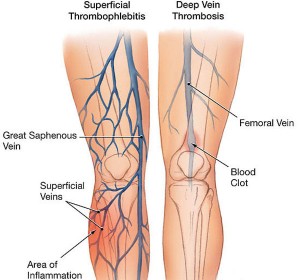
A Chicago Vein Expert on Thrombophlebitis
Thrombophlebitis is the catch all term that encompasses all of the conditions that are associated with blood clots inside the veins. One of the most commonly talked about venous clotting conditions is deep vein thrombosis (DVT). If you’ve done much reading on our website, you probably already know that DVT is a dangerous type of thrombophlebitis in which a blood clot forms in the deep leg veins. You might also be aware of the potential hazards of DVT such as pulmonary embolism, disability, and death.
What about other forms of thrombophlebitis? Keep reading to learn about how superficial thrombophlebitis compares to DVT, the consequences of this condition, and when to seek varicose vein treatment in Chicago.
What do Chicago residents need to know about thrombophlebitis?
Thrombophlebitis is a general term for a blood clot in one or more of your veins. You have many veins of differing shapes and sizes that can be affected by blood clots, but the veins in your legs are more likely to form clots because of gravity and lifestyle factors. Less commonly, though, thrombophlebitis can develop in veins anywhere in the body.
DVT, as you already know, affects deep lying leg veins. But when the veins nearer to the skin surface (superficial veins) are blocked, the condition is called superficial thrombophlebitis. Thrombi (blood clots), whether in deep veins or surface veins, can develop as a result of disease, injury, or long stints of inactivity (such as when bed-ridden). They can also form in veins that have become varicose.
People who have DVT are at a high risk for severe medical issues such as pulmonary embolism and stroke, because the deep leg veins are a direct line to the major organs in the body. Superficial thrombophlebitis, on the other hand, rarely requires medical intervention and isn’t as concerning as DVT. The superficial veins are largely suppliers of nutrients to bodily tissues and don’t pose a severe threat to a person’s health.
Superficial thrombophlebitis symptoms
Superficial thrombophlebitis often presents symptoms similar to those of DVT. Because DVT is a medical emergency, it is in your best interest to seek care from a Chicago vein treatment center right away in order to assess your condition and begin any necessary treatment plan.
Symptoms of superficial thrombophlebitis include:
- Redness
- Inflammation
- Warm skin
- Pain and tenderness
- Skin discoloration
- Vein hardening
Treatment options for superficial thrombophlebitis
DVT requires immediate medical attention, but superficial thrombophlebitis usually clears up on its own with at home care. Spider vein doctors in Chicago frequently recommend applying a warm, wet compress to the affected area to moisturize the skin and relieve pain. Compression and elevation are beneficial for reducing swelling and can help reduce discomfort. Additionally, ibuprofen and other anti-inflammatory medications can help calm redness and pain produced by inflammation inside the blocked vein.
This condition often resolves in a few weeks, but vein removal in Chicago might be warranted in extreme cases. Fast and painless in-office procedures may be used in these instances.
Chicago Vein Care Center is home to Dr. Ramon Castro, a Chicago vein expert highly trained and experienced in the underlying venous disease that causes blood clots in both the superficial and deep leg veins. Feel free to learn more about Dr. Castro and his team by visiting www.yourveinexpert.com.
